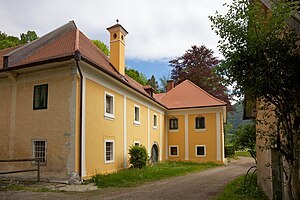Scythe forge on the Pfuster
|
|||

|
|||
| location | |||
| Address: | Eisbach | ||
| Cadastral municipality: | Obermicheldorf | ||
| Coordinates: | 47 ° 52 '3.5 " N , 14 ° 8' 4.2" E | ||
| history | |||
| Founding: | around 1558 | ||
| Shutdown: | 1904
|
||
| Character: | Zwei Kreuz zwei Laibl (1666) | ||
The former scythe smithy on the Pfuster , also Pfusterschmiede or Pfuster for short , is a listed ensemble of industrial culture in Micheldorf in Upper Austria in the Kirchdorf an der Krems district . The scythe factory was built around 1558 and shut down in 1904. The Pfusterschmiede is generally considered to be the oldest of all Micheldorfer scythe smiths, which is mainly due to the documentary mention in 1334. Since when scythes were actually made on the Pfuster cannot be answered with certainty, as with many scythe makers.
location
The scythe forge on the Pfuster is located on the uppermost course of the Krems in the cadastral community of Obermicheldorf and is the top scythe forge on the Krems. Above the Pfuster there were several powder mills on the Krems . The kingdom of heaven biotope is located nearby today.
history
The blacksmith's shop was compulsory for the manor of Pernstein . In 1334, the "Gütlein, which is located near St. Georgenberg, which is called the Pfuster " was first mentioned in a document. The first master known by name was Thomas Pfusterschmid in 1580 , who struck the symbol "A heart" on his scythes. His son Wolfgang Pfusterschmid used the symbol "Three Hearts". In 1666, Simon and Elisabeth Moser bought the Pfuster from the scythe forge under the linden tree, bringing the sign "Two crosses and two loaves" with them. In 1807 the entire property was sold by the Moser family to Franz Holzinger von der Schützenhub , who in turn married Theresia Pfusterschmid . In 1840 the Pfuster was bought by Carl Zeitlinger , who already owned the scythe smithy for Dörflern . The history of the scythe factory ended with his son Gottfried Zeitlinger , who died suddenly in the Pfuster in 1902, and the hammer building was demolished in 1904. The preserved buildings are now privately owned and are constantly being renovated.
Buildings
The scythe factory consisted of numerous structures, some of which are still preserved today.
Mansion
In the keystone over an archway with the sign "Zwei Kreuz" and "WM BM" (Wolfgang Moser, Anna Barbara Moser). Another gate entrance re. "S. 1839 H. “(Susanna Holzinger). Wrought iron window grilles on the upper floor with the hammer sign "Two Cross". On one corner a wall painting uncovered during the last renovation, the St. Performing George. The manor is a listed building.
Granary
The granary opposite the manor is a listed building.
Pfusterhammerl
The so-called Pfusterhammerl is located above the manor house on the Krems and is a listed building.
Garden with garden shed
The wooden garden shed is a listed building.
Wayside chapel
The path chapel bears the initials of its builder in the baroque wrought iron grille, "MJM" (Marianne and Jakob Moser, masters from 1757).
Pfusterkreuz
Large baroque wrought iron grave cross from the Kaltenbrunner family of scythe smiths, around 1735. Signed with the hammer mark “Winkel Maß” from the former scythe forge to Dörflern and the initials “SKP” and “TKP” for Simon Kaltenbrunner and Maria Theresia Kaltenbrunner. It was probably installed at its current location near the Pfuster after 1840 and has been known as the "Pfuster Cross" ever since. Restored in 1955/57.
See also
literature
- Franz Schröckenfux: History of the Austrian scythe works and their owners . Linz - Achern, 1975
- Franz Neumeyer: Heimatbuch Micheldorf (1997)



